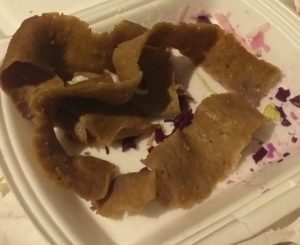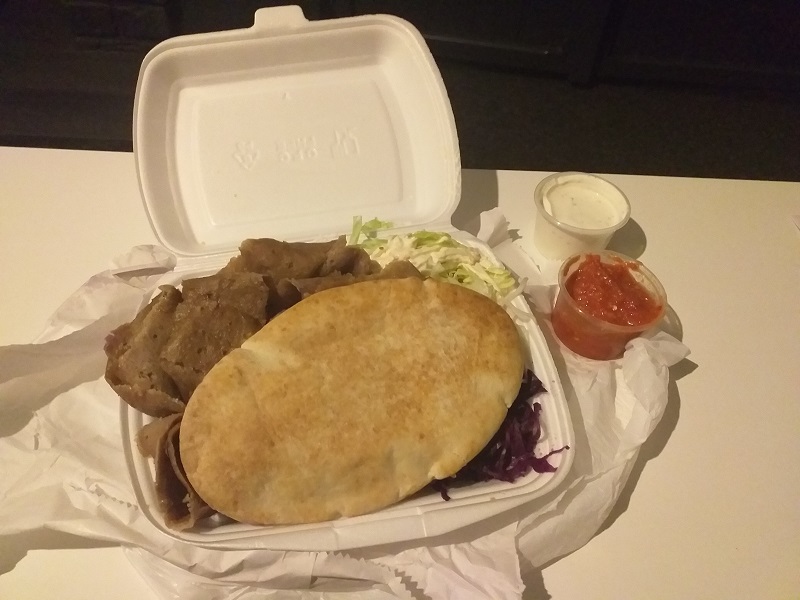British doner kebabs are different from the ones you get in many other European countries. In fact, the takeaway food classed as a doner can vary considerably from one European country to the next.
Differences between kebabs in European countries include the kind of bread the doner meat is served with and the choice and variety of salad but the greatest difference between British doner kebabs and one available in other European countries is the meat. It’s predominantly lamb and it tends to be a lot greasier than the meat in other European kebabs.
What is a British Doner Kebab?
In Britain, doner kebabs are always served with a piece of pitta bread. In my experience, anyway, but I have been gone for a while.
There’s also a selection of salad items including red and white cabbage, and tomatoes.
As with the kebab shops in other European countries, British kebab shops often offer a chicken option, but the main kebab meat is lamb.
I say it’s lamb because that’s the predominant taste and the meat is generally pretty greasy. A lot greasier than the kebab meat I’ve eaten in other parts of Europe.
However, from what I’ve read, the tree trunk-like slab of meat you see spinning behind the counter is actually a mixture of meats that is dominated by lamb.
In other parts of Europe, the meat spinning on the rotisserie is more likely to be beef or pork, depending on which country you are in.
I ate my first doner kebab 30 years ago. I got it at the end of a night out in Northallerton. It was wrapped up in paper in a similar way to British fish and chips. Everything was tossed in there, including the sauces.
These days, if you go to a British kebab shop you generally get everything in a polystyrene box. The box is often placed in a paper bag with the pitta bread sitting on top.
As for the choice of sauces, there are always two—garlic sauce and chili sauce—and many kebab shops provide them in little pots instead of pouring it over the meat and vegetables like they used to do.
Eating Kebabs and Kebabs in Europe Gave Me Culture Shock
I can’t remember being offered a pitta bread in the kebab shops I visited after I left the UK and I’ve been around:
- The Netherlands
- Spain
- Portugal
- Germany
- The Czech Republic
- Romania
- Ukraine
- Moldova
- Italy
- Albania
- North Macedonia
- Serbia
- Hungary
- France
Serving the kebab meat in Turkish bread seems to be popular. I often ate kebabs served that way in the Netherlands and I’ve come across it in other European countries as well.
The kebab I bought in the Czech Republic was served in a durum wrap. As well as meat and vegetables, it had chips inside. It looked like a shawarma but the sign behind the counter called it a doner kebab. The kebabs I ate in Ukraine were served in a similar way.
I can’t remember garlic sauce ever being an option in any of the European countries I’ve visited so far. More often than not it’s a white sauce of some kind, possibly yogurt, but if there was any garlic in there I couldn’t taste it.
 In Britain, the kebab meat is generally served in long, thick strips. After cutting it, the kebab shop personnel generally douse it in a pot of boiling water. It appears to be a hygiene thing.
In Britain, the kebab meat is generally served in long, thick strips. After cutting it, the kebab shop personnel generally douse it in a pot of boiling water. It appears to be a hygiene thing.
The kebab meat in most of the other countries I’ve been is generally cut a lot thinner and smaller. More like meat trimming or shavings than meat slices.
Instead of dousing the meat in water, it’s allowed to sit a while on the hot plate below the rotisserie and may even be turned a few times with a spatula to make sure it’s nicely heated through.
My Opinion of British Doner Kebabs
When I returned to Britain at the end of 2019, after several years of living abroad, one of the first things I did was buy a doner kebab. I wanted to see if it tasted the way I remembered it and it did.
British doner kebabs are okay but I don’t think I would enjoy them without the garlic sauce. I always look at all the vegetable and kid myself it’s healthy. The truth is, the meat is so greasy it’s not a healthy option at all.
Apparently, a typical British doner kebab contains around 2,000 calories [https://www.coachmag.co.uk/nutrition/healthy-eating/1183/how-many-calories-kebab]. That’s a lot. Two thousand calories is the amount of energy the average woman needs to consume a day to maintain her present weight. A doner can provide that in a single sitting.
The average guy can eat 2,500 calories per day but paint it any way you want, British doner kebabs aren’t something you want to be eating very often.
Given the choice between a British doner and a Greek gyro, I’d choose the gyro every time. Although the portion is smaller and there are not so many vegetables, the meat has a better flavor and the tzatziki sauce also tastes great.
Albanian souvlaki are very similar I’d choose one of those over a British doner as well but some of the kebabs I’ve eaten in other parts of Europe were so poor Id rather go red, white, and blue.
A Short Disclaimer
I don’t claim to be an expert on doner kebabs and, no matter what country you are in, I’m sure the quality can vary a lot from one kebab shop to the next.
This blog post is based on my own experiences eating doner kebabs in Britain and the other parts of Europe.
If you disagree with something I’ve said or have the information you’d like to share, please leave a comment in the comment section below.
Why in the blue Hell would I choose to write a blog post about doner kebabs? It’s a strange choice, I admit it, but the truth is I was amazed how much a simple thing like a kebab can change from one country to the next. That’s it, the truth in a teacup and, just for the record, I generally eat very healthy. Kebabs (in all their various forms) are only an occasional indulgence.
– – – – –
– – –
– – –
– – – – –

Nowadays small portion kebabs tend to be served in Pitta bread while large portion are served in a Naan or other flatbread and you will have the option of adding a skewer of Tikka or a skewer of Shish. If you order a mixed grill kebab (Doner, Tikka and Shish) you may be served the meat, two flatbreads and salad separately for you to make your own.
Hi, what part of the world are you referring to, the UK or elsewhere in Europe?
The meat and salad is usually served Maude the split outta, theoretically making it possible to eat it with one hand…theoretically…
The meat is not always kept in hot water, which is simply there to keep the meat hot, once it is carved off of the main piece, as it cooks from the outside.
You may end up with donner meat straight off if the rotisserie, depending on how busy it is.
The confusing structure of the British kebab has always left me disappointed. What point does the bread have on the top or bottom. Wrapped gyros/burrito style is the only way everything can be enjoyed in a single bite.
Hi,
I suppose the pitta provides a way of making form of sandwich. I tend to often dislike the meat more than the bread. Given the choice though, I’d much rather have wrapped option like you mention such as a gyro or souvlaki.
The contents should be inside the split pitta, if it’s done correctly.
I prefer it where it comes in a naan, that you can fold in half, but I guess that that’s a bit of a “fusion.”